AMD Radeon HD 4670: Ruling from Top to Bottom
by Derek Wilson on September 10, 2008 12:00 AM EST- Posted in
- GPUs
Radeon HD 4670 vs. Last Year's $200 Offerings: The 3870/3850 Revisited
This is an interesting comparison. We included the 3850 in our 9500 GT article, as it was a fairly popular part that had fallen to $100. This time around we throw in the 3870 in order to see how the reduced clock speed and architectural changes impact performance. Let's take a look at the mayhem.
The 4670 really takes the 3850 to task under Crysis with medium settings. Impressively, the 4670 stays above 30 fps at 1920x1200 and does a fair job of paralleling the performance of the 3870 at about a 10fps deficit after 1280x1024.
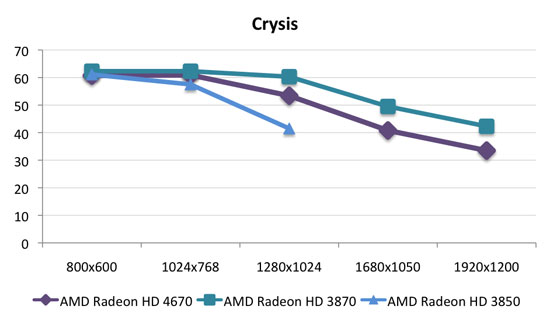
Our Enemy Territory benchmark has everything maxed out plus a little 4x antialiasing action. At low res, the 4670 actually leads the pack here. This is quite impressive and is our first inkling that maybe our hope about AA performance will prevail. The increased ROP power of the 4670 might also have an impact here, but either way this isn't a bad showing.
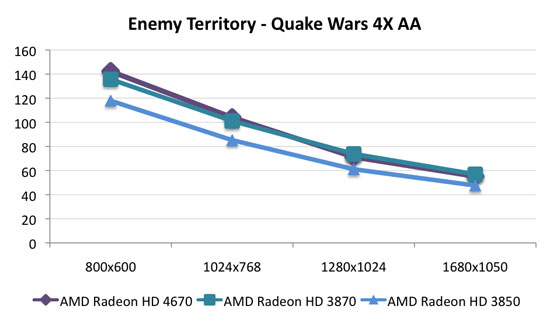
Both the 3870 and 3850 lead the 4670 in Oblivion with ultra high defaults and no AA. The 4670 remains playable up through 1680x1050, which is quite nice. But nothing really interesting happens until we consider what happens when we flick on the AA switch.
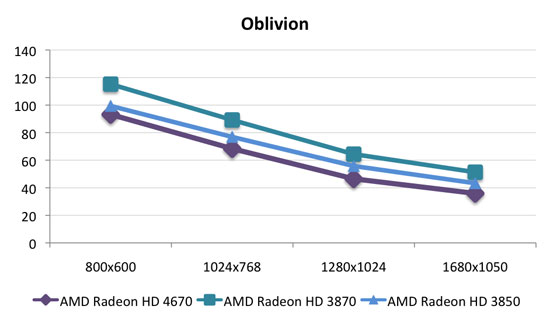
With 4xAA and 16xAF enabled, the tables are turned and the 4670 jumps on top. Staying barely playable at 1680x1050 with 4xAA (we'd still recommend dropping back to 1280x1024 though), the 4670 certainly looks to be on pace for delivering mainstream hardware with usable AA for resolutions that really need it while running at high quality settings.
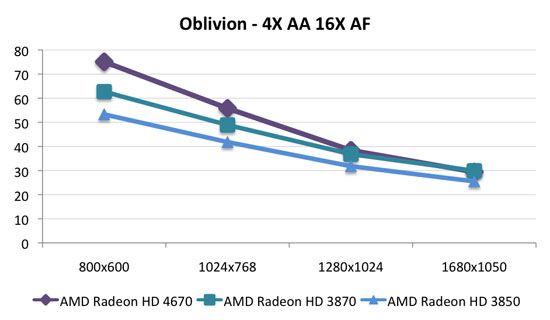
With Age of Conan, 1024x768 is really the highest res we can manage on the 4670 with high quality. The card performs similarly to the 3850 here.
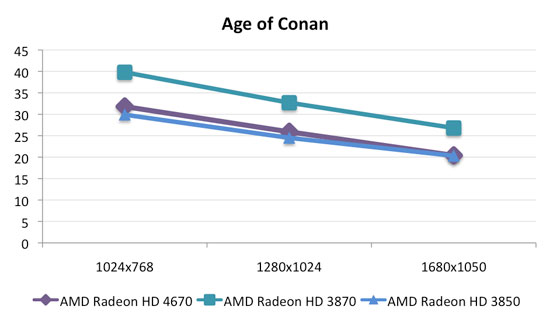
While AoC and GRID are ruled by the 4850 and 4870, the 4670 does lag the 3800 series cards. The game is still incredibly playable at 1280x1024 and we'll have to explore AA in this game a little later on as well.
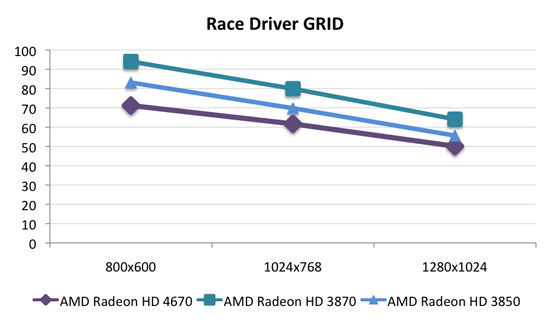
Last is a look at Crysis with high quality settings (and very high quality shaders). This is a tough benchmark and we only compared the 4670 against the 3870 here. The 4670 can't quite attain playability at 1280x1024 either. Looks like something between medium and high quality would suit the 4670 best.
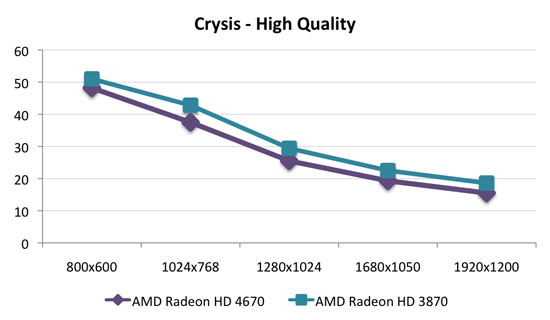










90 Comments
View All Comments
djc208 - Wednesday, September 10, 2008 - link
"I know the point of the article maybe to compare the various GPUs as fairly as possible but these aren't real world figures because I think you'd be hard pressed to find someone in the real world who will use a budget GPU with an ultra high-end CPU."The testing is to compare what the card is capable of. If you pair it with lower end components then you introduce more variability into the mix. Is the game CPU or GPU limited at that resolution? Since no current games really use a quad core CPU then matching the number of cores is less important than matching the architecture and speed of the test CPU.
Plus if you run similar tests on your system with your CPU you can use this data to figure out where you're best off spending upgrade money in the future. If you can't get the same FPS at the same resolution then a CPU upgrade is going to help more than another GPU upgrade.
Gastrian - Wednesday, September 10, 2008 - link
I should have worded it slightly different, when we upgrade we buy a new base unit and pass the older unit on to someone else so comparing it in that way wouldn't work as it will be a new CPU and GPU.The entire base units we were pricing up were half the price of the CPU used in this test and those base units include the AMD 4850 on a DDR2 motherboard.
If you look at some of the Phenom reviews running Crysis (latest CPU reviews with benchmarks), they don't include the Q9770 which is running at 3.2GHz but do have the E8400 3.0GHz intel chip beating a X2 5600+ 2.8GHz AMD chip by almost 20FPS at 1024x768 at medium settings and the Intel chip is £50 more expensive.
The review says this GPU will play Crysis but if you put it with a CPU aimed at the same market segment it won't, therefore the benchmarks paint completely the wrong picture as the 4650 may not be suitable for a budget system and you'd be better off paying the extra and getting a 4850.
Spacecomber - Wednesday, September 10, 2008 - link
If a 4650 is significantly throttled by the CPU in a system, it usually won't make a big difference to go to a faster GPU to try to get around this. At the lower resolutions, they'll both be waiting on the CPU. In other words, neither card is in an environment where it can fully utilize its capabilities.toyota - Wednesday, September 10, 2008 - link
that doesnt even make sense. you dont go with a faster gpu to overcome cpu limitations. if you play Crysis on medium at 1024 with a really slow cpu adding a fast gpu wont make much differnce. it will allow you to bump up settings and res though.Gastrian - Wednesday, September 10, 2008 - link
I wouldn't call an AMD X2 5600+ a "really slow CPU", especially for about £55.It specifically states in the article;
"Additionally, for the 4670, only two of these numbers are less than playable and one is borderline. In general, the 4670 shows that at 1280x1024, it can handle all the current games you might throw at it. In the tests where AA is enabled, the 4670 shows that it has an added advantage, which matters much more at low resolutions than high ones."
The 9600GSO is a rebranded 8800GS which is a slightly underpowered 8800GT.
In the Crysis benchmark with the Q9770 the 9600GSO gets over 60FPS at 1024 x 768. In the same benchmark for the Phenom X3 review, with a slightly more powerful GPU, the AMD X2 5600+ only gets 45 FPS, thats 75% of the performance. At the 1280x1024 Crysis benchmark with 4xAA the 4670 is only able to get around 30fps, now if we apply the 75% performance of the X2 5600+ the AMD 4670 is only getting just over 20fps which is not exactly playable.
By using the Q9770 in the review Anandtech have given all these cards a performance increase they wouldn't get in the real world. This is okay in most reviews as you are just comparing cards but at the bottom end you are also making sure that they don't go below a certain level of performance, this review shows them being above that line while actual users may experience something completely different.
derek85 - Saturday, September 13, 2008 - link
The main point of using a fast CPU is to eliminate the possible bottleneck from CPU, thus comparing purely the performance of GPU. If you use a CPU that would introduce a bottleneck during benchmark you would get same FPS from multiple GPUs not knowing which one is better, and this defeats the whole purpose of a review.pattycake0147 - Wednesday, September 10, 2008 - link
I'd just like to let you know that I feel the same way you do. IMO there should be a lower end CPU (X2 5600) to show some numbers closer to what you or I might experience, as well as a higher end part (Q9770) to show a less CPU limited environment. Unfortunately AT doesn't cater to those of us who would like some more realistic numbers.JarredWalton - Thursday, September 11, 2008 - link
It has nothing to do with "realistic"... it's all about time. If it takes late nights just to get one set of numbers finished, doubling the number of tests means you'll miss the launch dates of pretty much every new piece of hardware - or you'll cut tests to make it. There are only so many hours in a week, and that's often what you have to complete testing of a new GPU.Besides, if a top-end CPU to avoid bottlenecks isn't good enough and you add one other CPU, then someone else wants yet another point of reference, and it just goes from there. We have CPU articles where the GPU is kept constant so you can see CPU scaling, and we have GPU articles where the CPU is constant so you can see GPU scaling. Most games are GPU limited, particularly at high detail settings, but I'd still go with a faster CPU if you can afford it.
Gastrian - Wednesday, September 10, 2008 - link
But that is the environment its going to be placed in.All this review shoes is that a Q9770 can play Crysis with very little concern for the GPU and that the 4670 is better than a 9600GSO but that ignores the issue that neither the 4670 or 9600GSO may play games.
Building on a budget I have to ask myself a simple question, is it worth spending xx amount on a GPU that will give me a performance boost but not still enough to adequately play games or do I spend the same amount on a more powerful CPU and stick with an IGP like the AMD 780G. Neither will play games BUT the more powerful CPU will be more useful in better areas. This doesn't answer that question and I'm still none the wiser as to whether to buy this card or not.
djfourmoney - Wednesday, September 10, 2008 - link
I agree the conclusion is a bit like sour grapes.I had a HD3870 for $119, that cheap IMHO no rebate needed to get that price but after tax it grew to $129 and for the amount of performance I got for that price, I was impressed -
GRID Demo 1.1 50+fps@1920x1200 Ultra AAx2
However, I had to remove a TV Tuner card to use it. So I took it back, I like to watch local HD broadcast of NCCA College Football and NFL Football too much to leave that tuner out.
Yes I could go with a 9600GT single slot (No GSO here) for $99-150 on New Egg
Or a Sapphire HD3850 for $94
But the HD4670 is $79 and shouldn't be more than that, even at B&M's and might be slightly less online depending on bulk purchases by companies like TigerDirect and New Egg.
It fits the bill, yes I have to take down my default resolution from 1920x1200 in GRID to say 1280x768 which is 720p and at that resolution it should play at 50-60fps on High, AAx2. GRID looks so good even at medium detail, I don't mind turning it down a notch or two just to make it run faster. If I can run it 60fps at 1920x1200 in Medium, that's plenty for me.
I'm not uninformed or uneducated about PC Products, far from it. I know the HD4850 1GB from Sapphire would be highly ideal in my system but I don't want to spend $200 for a card, okay? Why should I hold myself to the standards of somebody else when I'm not a hardcore gamer/overclocker at heart, just somebody that wants to play a cool game like GRID at a decent frame rate and detail. While it would be great to get more performance, you would have to go up to a HD3870 to really out distance the HD4670 and as I told you with this mATX board it just won't work and allow my two TV tuners to live in harmony.
Thus HD4670 does what I needed to do and its not because I'm a cheap SOB or uninformed. I am informed, making this an ideal choice for me at my pre-set budget limit.
You should updated this with a pair of these Crossfire'ed I understand performance is pretty good for a couple of "budget" cards....